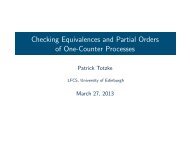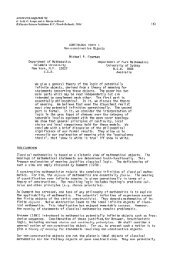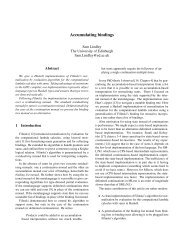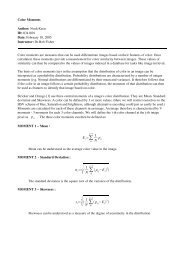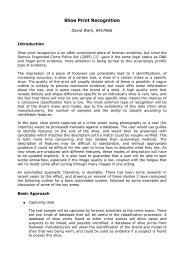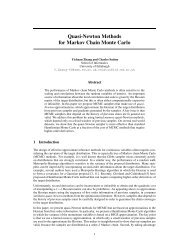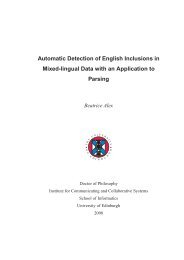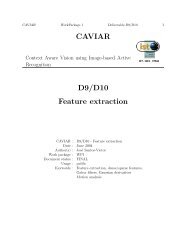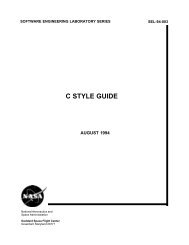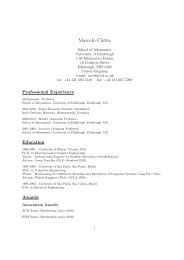The Effectiveness of Health Care Teams in the National Health Service
The Effectiveness of Health Care Teams in the National Health Service
The Effectiveness of Health Care Teams in the National Health Service
Create successful ePaper yourself
Turn your PDF publications into a flip-book with our unique Google optimized e-Paper software.
Audio record<strong>in</strong>g was done with two omni-directional PZM tabletop microphones<br />
l<strong>in</strong>ked to different channels <strong>of</strong> a high quality audiotape recorder; <strong>the</strong> microphones<br />
were set up so as to maximise channel differentiation but to be unobtrusive enough<br />
that participants would not move <strong>the</strong>m. A s<strong>in</strong>gle static video camera on a tripod was<br />
tra<strong>in</strong>ed to record <strong>the</strong> gross movements <strong>of</strong> as many <strong>of</strong> <strong>the</strong> participants as possible;<br />
this record was used only to aid speaker identification dur<strong>in</strong>g transcription. Before<br />
each meet<strong>in</strong>g was opened all participants <strong>in</strong>troduced <strong>the</strong>mselves and <strong>the</strong>ir<br />
occupation and upon <strong>the</strong> basis <strong>of</strong> this each was allocated a speaker number.<br />
<strong>The</strong>refore <strong>the</strong> first person to <strong>in</strong>troduce him or herself became speaker 1, <strong>the</strong> second<br />
speaker 2 and so on.<br />
Meet<strong>in</strong>gs were transcribed from <strong>the</strong> audiotapes by an audio typist who had not<br />
attended <strong>the</strong> meet<strong>in</strong>g. Audio typists transcribed complete contributions <strong>in</strong> order,<br />
accord<strong>in</strong>g to when <strong>the</strong>y began, labell<strong>in</strong>g each contribution by speaker number, but<br />
did not code f<strong>in</strong>er tim<strong>in</strong>g <strong>in</strong>formation. Speaker identification was facilitated both by<br />
<strong>the</strong> video record<strong>in</strong>g and by a seat<strong>in</strong>g plan drawn up dur<strong>in</strong>g <strong>the</strong> meet<strong>in</strong>g by <strong>the</strong> person<br />
record<strong>in</strong>g <strong>the</strong> meet<strong>in</strong>g. A contribution was def<strong>in</strong>ed as a period <strong>of</strong> speech from one<br />
<strong>in</strong>dividual <strong>in</strong> which <strong>the</strong> only major pauses co<strong>in</strong>cided with silence from <strong>the</strong> o<strong>the</strong>r<br />
speakers, so that <strong>the</strong> pause was likely to be caused by <strong>the</strong> speaker th<strong>in</strong>k<strong>in</strong>g and not<br />
by <strong>the</strong> speaker listen<strong>in</strong>g to someone else's contribution. Under this def<strong>in</strong>ition,<br />
speakers cannot follow <strong>the</strong>mselves <strong>in</strong> <strong>the</strong> speak<strong>in</strong>g order. Overlapped speech was<br />
transcribed, with <strong>the</strong> extent <strong>of</strong> <strong>the</strong> overlap roughly marked. Infrequently, parts <strong>of</strong> <strong>the</strong><br />
meet<strong>in</strong>gs were omitted because <strong>the</strong>y were so badly overlapped that we could not<br />
track <strong>in</strong>dividual contributions. After transcription, <strong>the</strong> transcripts were completely<br />
anonymised tak<strong>in</strong>g out all staff, patient, place names, place and local authority<br />
names or possible team or person identifiers.<br />
An example transcription excerpt is given <strong>in</strong> Figure 2.13. Transcription proceeds one<br />
contribution per row. Column one conta<strong>in</strong>s <strong>the</strong> speaker number. Column two<br />
conta<strong>in</strong>s <strong>the</strong> words said, with cod<strong>in</strong>g <strong>in</strong>formation <strong>in</strong> a different font, and column three<br />
conta<strong>in</strong>s any notes which <strong>the</strong> transcriber wished to make (for <strong>in</strong>stance, about people<br />
enter<strong>in</strong>g or leav<strong>in</strong>g <strong>the</strong> room). 5<br />
5 In previous work us<strong>in</strong>g <strong>the</strong>se methods on four to twelve person meet<strong>in</strong>gs, transcribers were<br />
able to agree very reliably who made any one contribution; us<strong>in</strong>g <strong>the</strong> kappa statistic, K=.93, k<br />
= 2, N = 230, with an average <strong>of</strong> 2% and a maximum <strong>of</strong> 6% non-backchannel contributions<br />
left as unidentified.



